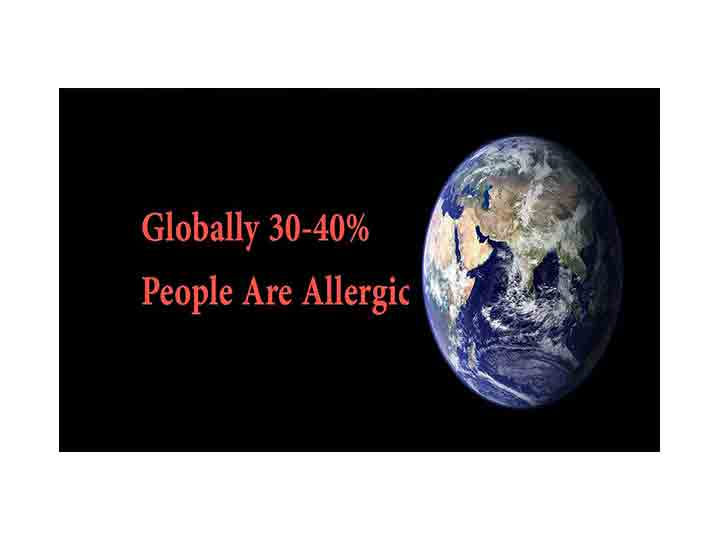Allergies are Global Health Issue
The term Allergy coined by the Pediatrician Clemons von Pirquet
Allergies are common and increasing globally
Worldwide 30-40% populations are allergic
In India 20-30% populations are allergic
Allergy may be very severe and life threatening
Adrenaline is the drug of choice in anaphylaxis
Avoidance of the causative allergen is important
If your child has anaphylaxis, ensure your child is safe in all environment including at school
Always consult an Allergist if you experienced anaphylaxis
Few allergies in children may be disappeared when he grows
Types of Allergy
Food Allergy:
Incidence is more in Children.
Egg, milk, peanut, shellfish, wheat, soy are important food allergen.
Skin Allergy:
Very common. Etiology difficult to find out. Eczema, Hives, Contact Dermatitis are example.
Pet Allergy:
Can cause runny nose, watery eyes, sneezing. Can cause constant symptoms. Avoidance is the treatment.
Dust Allergy:
Dust Mites are important indoor allergen. Can trigger Allergic Rhinitis, Asthma , Eczema.
Eye Allergy:
Causes itching, redness, watering of eyes. Pollen, dust mite, pet dander can trigger symptoms.
Insect Allergy:
Relatively less common. Honeybee, wasps, yellow jacket, hornets, fire ants sting can cause allergy.
Major Allergens
Dust Mites
Major allergen worldwide. Microscopic. Feeds human skin scales and debris. Acts as perennial allergen. Important cause of Asthma.
Pet Dander
Cat, Dog, Rodents. There are no non allergic dogs. Cat allergen can stay long even for 6 months after cat removal from home.
Pollen
Allergenic pollen generally wind borne from grasses, trees. Mainly cause Allergic Rhinitis.Rainfall can influence abundance.
Cockroach
Two species American and German. Live in warm and humid places. Can be airborn when they are disturbed. Linked to Asthma.
Mold
May cause seasonal and perennial symptoms. Grow in warm, humid environment. Alternaria, Aspergillus important.
Food & Drugs
Cows milk, egg, shellfish, pea nuts and soy are most important. Inhalant allergen can cross react with foods.
Risk Factor For Allergy
Family history of Atopy
One parent atopic 50 % increase risk, both parent atopic more than 62 % risk increase in children. None are atopic chance is less than 20 % in children.
Serum IgE > 100 IU/ml
Total serum IgE of more than 100 IU/ml in less than 6 years of age. However it is not specific.
Tobacco Exposure
Tobacco exposure in children can increase the risk of developing allergies. Stop cigarette smoking in home to prevent harmful effect on children.
Animal Contact
Animal dander, saliva, urine, hair, feather are the source of antigen. Cat antigen Fel d1 , Dog antigen Can f1 are important aeroallergen.
Dust Mite Exposure
House dust mite is a major allergen worldwide.They are microscopic. They feed human skin scales and debris. Important cause of perennial Asthma.
Eczema
Eczema or Atopic Dermatitis is a part of the atopic march. It may be associated with the development of several foods and environmental allergies.
Symptoms of Allergy
Symptoms of mild to moderate allergy include:
⇒Runny Nose, Stuffy Nose, Sneezing
⇒Wheezing, Shortness of Breath
⇒Cough
⇒Rashes
⇒Headache
⇒Nausea & Vomiting
⇒Fatigue
⇒Fever
Symptoms of severe allergy include:
⇒Generalized urticaria and angioedema
⇒Itching, tightness in the throat, hoarseness of voice
⇒Vomiting, diarrhea, cramp in the abdomen
⇒Respiratory difficulty/shortness of breath, cough, wheeze
⇒Weak pulse, dizziness, reduced BP
Only a few symptoms may be present. Severity of symptoms can change quickly
Management of Allergy
Consult with Allergist
Your first step to manage any allergic disorder is to consult with an allergist. Your Allergist can guide you and formulate a specific plan of management for your problem. Sometimes finding of Allergy Asthma Specialist in your locality may be difficult. So you can tell primary care physician for appropriate referral to Allergist. An Allergist is a specialist physician who have done special training in the field on Allergy Asthma Immunology and is the specialist physician to manage all allergy related conditions.
Do Skin Testing
After hearing your symptoms and evaluation of signs, your allergist will formulate a panel of investigation to find out the substances you are allergic to. Allergic skin prick testing or blood testing by appropriate method will be suitable test to know the precise cause of your allergic symptoms. Usually skin prick testing are cost effective. Skin testing must be done an expert in the field. Also a good antigenic material is necessary to perform the test. Blood testing is costly.
Treatment
After proper diagnosis your physician will prescribe you appropriate anti allergic medicine. There are two forms of treatment available for allergic patients. Medication and Immunotherapy. Decongestants and antihistamines are the most common allergy medications. Immunotherapy is the preventive treatment for allergic disorder. Immunotherapy is usually recommended only if the person seems to be selectively sensitive to several allergens.
Anaphylaxis
⇒Anaphylaxis is a medical emergency.
⇒The most severe form of allergy.
⇒Characterized by sudden, severe, life-threatening multi-organ hypersensitivity reaction.
⇒Most common signs are cutaneous symptoms, including angioedema, urticaria, erythema and pruritus.
⇒Immediate intramuscular administration of Adrenaline into the lateral aspect of thigh is first-line therapy for anaphylaxis.
⇒Always carry Adrenaline Autoinjector device if indicated.
⇒Be cautious while eating in social events or restaurants if you had anaphylaxis to food .
Symptoms of Anaphylaxis
⇒Respiratory Distress
⇒Angioedema
⇒Urtecaria
⇒Erythema
⇒Pruritus
⇒Dizziness
⇒Fainting
⇒Low Blood Pressure
⇒Vomiting
⇒Abdominal Pain
Causes of Anaphylaxis
Food
Food can cause anaphylaxis. Most important food include peanuts, tree nuts, shellfish, cow’s milk, soy products and eggs.
Insect Stings
Stinging insects like honeybees, yellow jackets, fire ants, hornets and paper wasps can cause anaphylaxis. Less commonly, biting insects.
Blood Transfusion
Blood transfusion can cause mild allergic reaction to severe form of allergy. Anaphylaxis can occur in approx 1 in 20,000 to 1 in 50,000 transfusions.
Medications
Medicines like β-lactams like penicillin,
Nonsteroidal anti-inflammatory drugs (NSAIDs) like aspirin and ibuprofen Biologic modifier.
Natural Rubber Latex
Latex is a common component of many medical and dental supplies including gloves, intravenous tubing etc, syringes, catheters.
Radiocontrast media
Allergy reactions to IV dye can occur ranging from mild to moderate reaction to more severe life-threatening anaphylatix reaction.
Management of Anaphylaxis
Lay person flat – do NOT allow them to stand or walk
- Laying the patient flat will improve venous blood return to the heart.
- The left lateral position is recommended for patients who are pregnant to reduce the risk of compression of the inferior vena cava by the pregnant uterus.
- Fatality can occur within minutes if a patient stands or sits suddenly.
Give adrenaline autoinjector
10-20 kg (~1-5yrs) – 0.15mg IM
>20kg (~>5yrs) – 0.3mg IM
Pregnant women, a dose of 0.3mg should be used
Repeat every 5 minutes as needed.
Transfer person to hospital
Call emergency services. Patient must be admitted to nearest hospital. Observe for four hours. If the vitals are stable then discharge.



